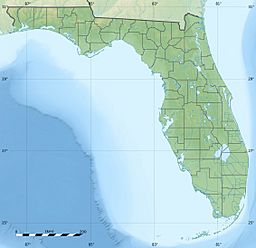Lake Osceola (Coral Gables) facts for kids
Quick facts for kids Lake Osceola |
|
|---|---|
| Location | University of Miami, Miami-Dade County, Florida |
| Coordinates | 25°43′06″N 80°16′45″W / 25.7184°N 80.2793°W |
| Type | man-made lake |
Lake Osceola is a cool, man-made lake right in the middle of the University of Miami's campus. It's a freshwater lake, which means it's not salty like the ocean. It's a really important part of the university and home to lots of interesting wildlife.
A Lake with a Past
Lake Osceola wasn't always a lake! It started as a canal. This canal was built to connect Biscayne Bay with other nearby water areas.
Later, when the University of Miami was being built in the late 1940s, this canal was changed into the lake we see today. Because the lake is connected to Biscayne Bay, many different kinds of animals, like fish and birds, started to live there naturally.
The lake got its name in 1929. The University of Miami's Iron Arrow Honor Society chose to name it after Osceola. He was a very important leader of the Seminole tribe and a famous historical figure in Florida.
Wildlife in Lake Osceola
Because Lake Osceola is connected to Biscayne Bay, many animals from the bay have made the lake their home. This includes different kinds of fish, birds, and reptiles.
Animals You Might See
While you won't find alligators or crocodiles in Lake Osceola anymore, there are still many other cool creatures. You might spot gentle manatees swimming around.
Many types of turtles also live in the lake. You can often see ducks and ibis birds on the water or near the shore. Some snakes, like cottonmouths, also live here. Plus, there are many different kinds of fish and tiny bacteria that call the lake home.
Keeping the Lake Healthy
Sometimes, lakes can have problems. Lake Osceola started having issues because of things like fertilizer runoff. This caused too much algae to grow at the bottom of the lake.
When too much algae grows, it uses up the oxygen in the water. This meant there wasn't enough oxygen for the fish, and many of them died. To fix this, the university put a big fountain in the middle of Lake Osceola.
The fountain helps to add more oxygen to the water. This makes the lake healthier for all the different kinds of animals that live there. It helps keep the lake's ecosystem balanced.


